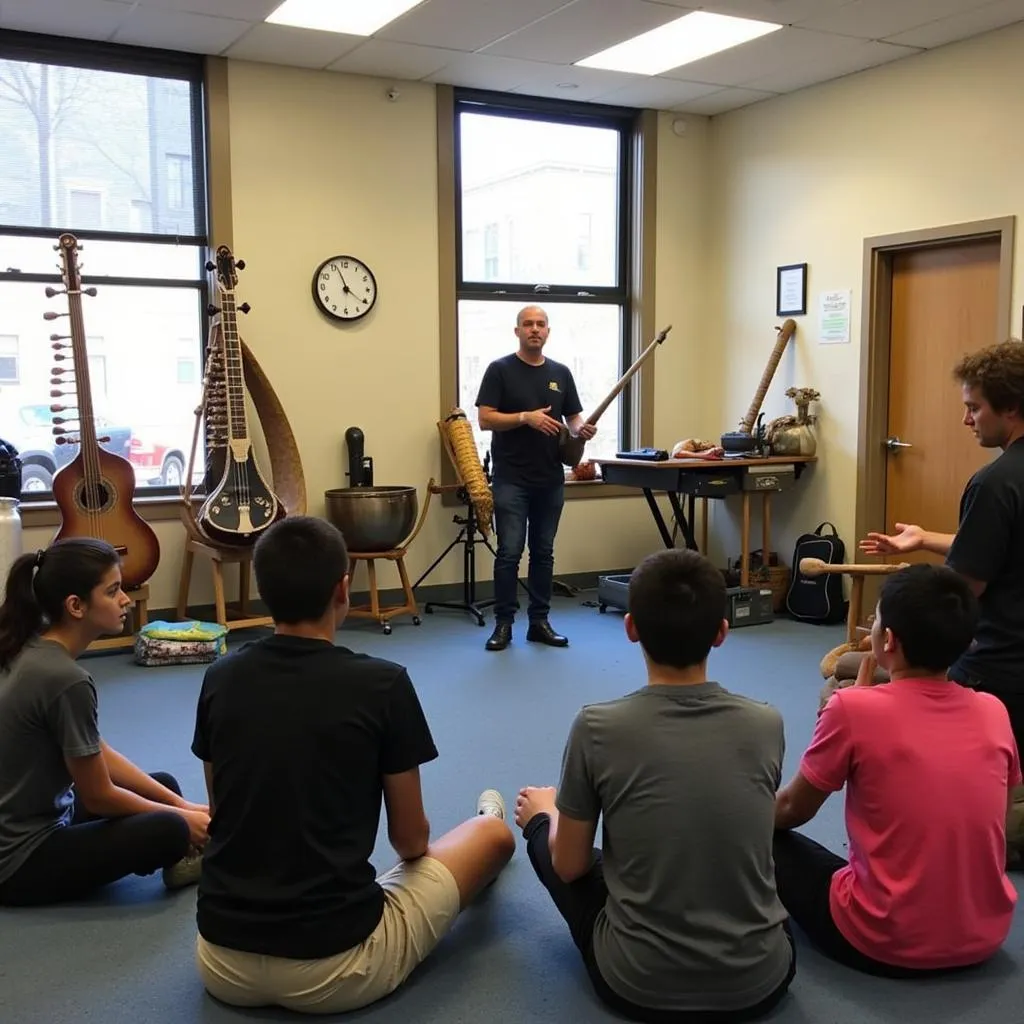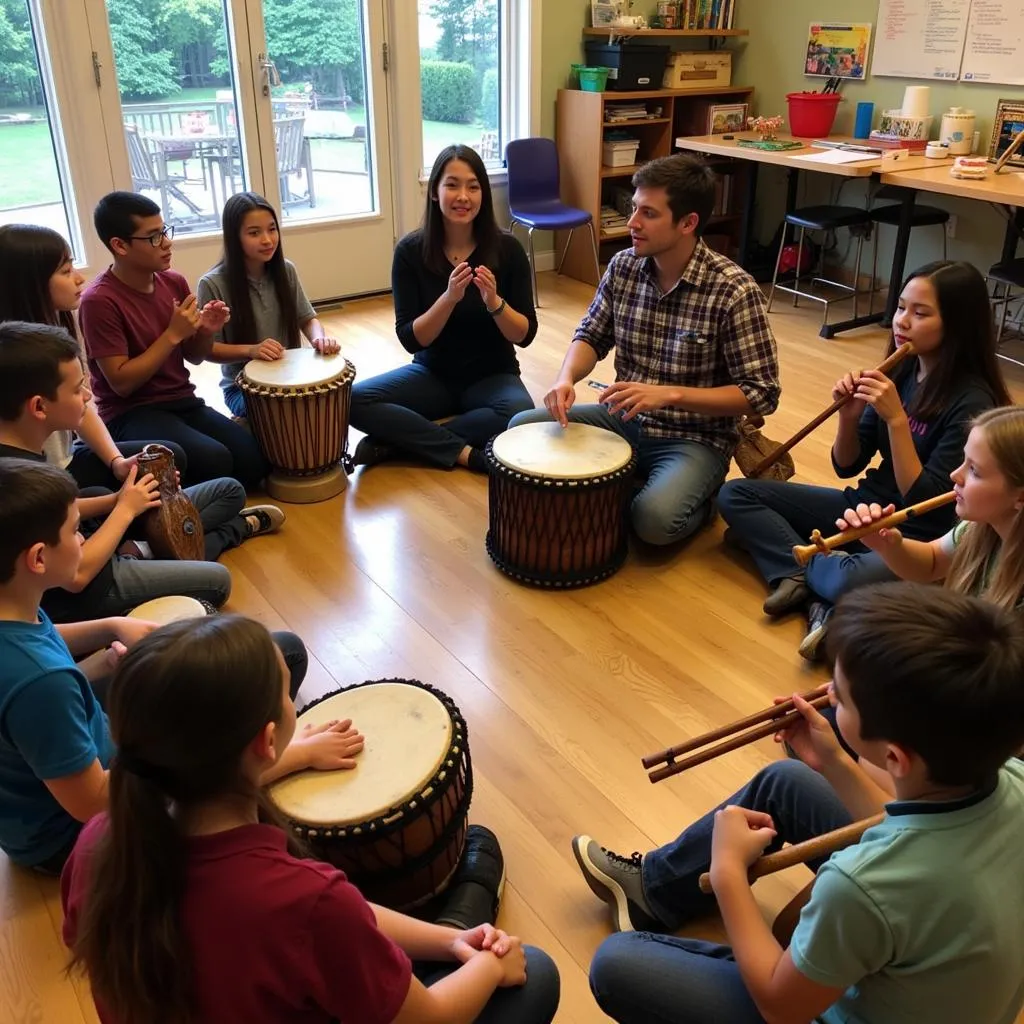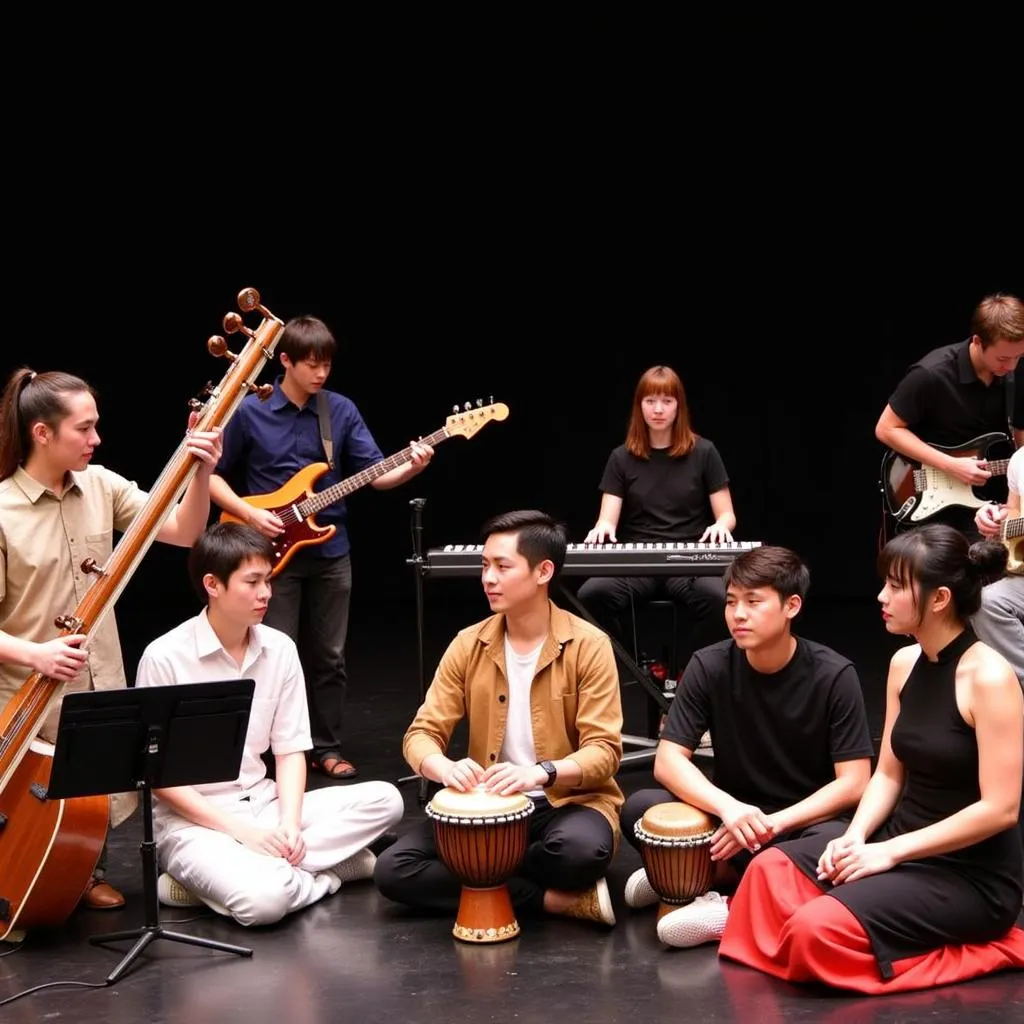The IELTS Reading section often includes passages about cultural topics, such as how traditional music and dance are incorporated into modern education. Today, we’ll explore a sample IELTS Reading test focusing on How Traditional Instruments Are Used In Music Classes. This practice will help you improve your reading skills and expand your vocabulary in this subject area.
Passage 1 – Easy Text
The Revival of Traditional Instruments in School Music Programs
In recent years, there has been a resurgence of interest in incorporating traditional musical instruments into school music programs. This trend reflects a growing appreciation for cultural heritage and the unique educational benefits that these instruments can offer. Many educators believe that exposing students to a diverse range of musical traditions can enhance their overall musical education and foster a deeper understanding of different cultures.
Traditional instruments, such as the sitar from India, the didgeridoo from Australia, and the steel pan from Trinidad and Tobago, are being introduced alongside more conventional Western instruments in music classrooms. These instruments not only provide students with new sonic experiences but also offer insights into the history and cultural significance of various musical traditions.
One of the primary advantages of using traditional instruments in music classes is their ability to engage students who might not be drawn to classical Western music. The unique timbres and playing techniques of these instruments can spark curiosity and enthusiasm among students, encouraging them to explore music more broadly. Additionally, learning to play traditional instruments often involves understanding the cultural context in which they were developed, thereby promoting cross-cultural awareness and appreciation.
 Traditional instruments in a music classroom
Traditional instruments in a music classroom
Questions 1-5: Multiple Choice
Choose the correct letter, A, B, C, or D.
What is the main reason for the increased interest in traditional instruments in schools?
A) To replace Western instruments
B) To reduce the cost of music education
C) To enhance cultural understanding and musical education
D) To make music classes more entertainingWhich of the following is NOT mentioned as a traditional instrument being introduced in schools?
A) Sitar
B) Didgeridoo
C) Piano
D) Steel panAccording to the passage, learning traditional instruments can:
A) Replace the need for learning Western instruments
B) Help students understand different cultures better
C) Simplify the music curriculum
D) Increase school funding for music programsThe text suggests that traditional instruments are particularly effective in:
A) Improving students’ mathematical skills
B) Preparing students for professional music careers
C) Engaging students who might not be interested in classical Western music
D) Reducing the time needed to learn musicWhat additional benefit of learning traditional instruments is mentioned in the passage?
A) It improves students’ language skills
B) It helps students understand the cultural context of the instruments
C) It guarantees better grades in other subjects
D) It prepares students for international music competitions
Answers:
- C
- C
- B
- C
- B
Passage 2 – Medium Text
The Pedagogical Value of Traditional Instruments in Modern Music Education
The integration of traditional musical instruments into contemporary music education curricula has been gaining momentum in recent years. This approach offers a multifaceted learning experience that goes beyond mere musical instruction, encompassing cultural education, historical understanding, and the development of diverse skill sets. Educators and music theorists argue that this inclusive approach to music education can yield significant benefits for students’ overall development and cultural awareness.
One of the primary advantages of incorporating traditional instruments into music classes is the opportunity for students to engage with a wider range of musical textures and timbres. Many traditional instruments produce sounds that are markedly different from those of Western classical instruments, thus expanding students’ auditory palettes. For instance, the resonant drone of the Indian tanpura or the complex overtones of the Tibetan singing bowl introduce students to new sonic possibilities, enhancing their understanding of sound production and musical aesthetics.
Moreover, learning to play traditional instruments often requires students to develop unique physical techniques and cognitive approaches. The intricate finger patterns required to play the West African kora, for example, can enhance fine motor skills and hand-eye coordination. Similarly, mastering the circular breathing technique used in playing the Australian didgeridoo can improve breath control and lung capacity, skills that are transferable to other wind instruments and even to non-musical activities.
 Students learning to play traditional instruments
Students learning to play traditional instruments
The cultural context of traditional instruments also provides a rich educational resource. By studying the origins and social significance of instruments like the Japanese koto or the Andean pan flute, students gain insights into the histories, belief systems, and social structures of diverse cultures. This cultural immersion can foster empathy, broaden worldviews, and contribute to a more inclusive and globally aware educational environment.
Furthermore, the inclusion of traditional instruments in music education can serve as a powerful tool for preserving cultural heritage. As globalization continues to homogenize cultural practices worldwide, the transmission of traditional musical knowledge becomes increasingly crucial. By learning these instruments, students become custodians of cultural traditions, ensuring that ancient musical practices remain vibrant and relevant in the modern world.
However, integrating traditional instruments into music curricula is not without challenges. Acquiring authentic instruments can be costly, and finding qualified instructors with expertise in diverse musical traditions can be difficult. Additionally, balancing the time allocated to traditional and Western classical instruments within limited class hours requires careful planning and curriculum design.
Despite these challenges, many educators argue that the benefits of incorporating traditional instruments into music education far outweigh the difficulties. This approach not only enriches students’ musical experiences but also prepares them to engage with an increasingly interconnected and multicultural world. As music education continues to evolve, the role of traditional instruments in fostering a more comprehensive and culturally responsive musical education is likely to grow in importance.
Questions 6-13: True/False/Not Given
Do the following statements agree with the information given in the passage? Write
TRUE if the statement agrees with the information
FALSE if the statement contradicts the information
NOT GIVEN if there is no information on this
Traditional instruments in music education only benefit students’ musical skills.
Learning traditional instruments can improve students’ physical coordination.
All traditional instruments are easier to play than Western classical instruments.
Studying traditional instruments helps students understand different cultures better.
The integration of traditional instruments in music classes is always successful.
Finding qualified teachers for traditional instruments can be challenging.
Traditional instruments are more expensive than Western classical instruments.
The use of traditional instruments in music education is expected to increase in the future.
Questions 14-18: Matching Information
Match the following features with the correct instrument or concept. NB You may use any letter more than once.
A. Tanpura
B. Kora
C. Didgeridoo
D. Koto
E. Pan flute
- Requires circular breathing technique
- Produces a resonant drone sound
- Involves intricate finger patterns
- Originates from Japan
- Comes from the Andean region
Answers:
- FALSE
- TRUE
- NOT GIVEN
- TRUE
- NOT GIVEN
- TRUE
- NOT GIVEN
- TRUE
- C
- A
- B
- D
- E
Passage 3 – Hard Text
The Synergistic Integration of Traditional and Modern Instruments in Contemporary Music Education
The amalgamation of traditional and modern instruments in music education represents a paradigm shift in pedagogical approaches, fostering a symbiotic relationship between diverse musical traditions and contemporary educational methodologies. This innovative synthesis not only enriches the musical landscape within educational institutions but also catalyzes a profound transformation in students’ cognitive, cultural, and creative development.
The juxtaposition of traditional and modern instruments in a single educational framework creates a unique sonic tapestry that challenges students to navigate complex auditory environments. For instance, the mellifluous tones of a Chinese guzheng alongside the digital articulations of a synthesizer compel students to reconcile disparate sound worlds, thereby honing their auditory discrimination and expanding their conception of musical possibility. This auditory juxtaposition serves as a metaphor for cultural dialogue, encouraging students to find harmony amidst diversity – a skill increasingly vital in our globalized society.
Moreover, the technical demands of traditional instruments often complement those of their modern counterparts in unexpected ways. The micro-tonal inflections common in Middle Eastern maqam music, as practiced on instruments like the oud, can enhance students’ pitch perception and intonation skills, benefiting their performance on equal-tempered Western instruments. Similarly, the polyrhythmic complexities inherent in West African drumming traditions can significantly improve students’ overall rhythmic acuity, translating into more nuanced performances across all musical genres.
 Traditional and modern instruments in a student ensemble
Traditional and modern instruments in a student ensemble
The integration of traditional instruments also facilitates a more holistic approach to music theory and composition. Many non-Western musical systems employ alternative tuning systems, modal structures, and compositional techniques that can broadenthe harmonic and melodic palette available to students. Exposure to the cyclical structures of Javanese gamelan music, for example, can inspire novel approaches to form and repetition in composition, while the improvisational ethos of Indian classical music can encourage greater spontaneity and creativity in performance.
Furthermore, the inclusion of traditional instruments in music education serves as a conduit for interdisciplinary learning. The study of these instruments often necessitates an exploration of the cultural, historical, and social contexts from which they emerged. This multidimensional approach fosters connections between music and other academic disciplines such as anthropology, history, and physics, promoting a more integrated and holistic educational experience.
However, the implementation of this integrated approach is not without its challenges. The acquisition and maintenance of a diverse instrument collection can strain educational budgets, and the development of a curriculum that gives equal weight to various musical traditions requires careful consideration and expertise. Additionally, there is a risk of superficial engagement with traditional instruments, potentially leading to cultural misappropriation or misrepresentation if not handled with sensitivity and depth.
Despite these challenges, the potential benefits of integrating traditional and modern instruments in music education are profound. This approach not only prepares students for a more diverse musical landscape but also equips them with the cultural competence and creative flexibility needed to thrive in an increasingly interconnected world. As educational institutions continue to evolve, the synergistic integration of traditional and modern instruments may well become a cornerstone of progressive music education, fostering a new generation of musicians who are as comfortable with the sitar as they are with the synthesizer.
Questions 19-23: Matching Headings
Match the following headings with the correct paragraphs. NB There are more headings than paragraphs, so you will not use all of them.
A. The challenge of cultural sensitivity in instrument integration
B. Complementary technical skills between traditional and modern instruments
C. Financial implications of diverse instrument collections
D. The impact on music theory and composition
E. Bridging cultural divides through sound
F. Interdisciplinary benefits of traditional instrument study
G. The future of integrated music education
- Paragraph 2
- Paragraph 3
- Paragraph 4
- Paragraph 5
- Paragraph 7
Questions 24-26: Sentence Completion
Complete the sentences below. Choose NO MORE THAN THREE WORDS from the passage for each answer.
The combination of traditional and modern instruments creates a __ that challenges students’ auditory skills.
Learning Middle Eastern instruments like the oud can improve students’ __ on Western instruments.
The study of traditional instruments often requires exploring the __ from which they originated.
Questions 27-30: Multiple Choice
Choose the correct letter, A, B, C, or D.
According to the passage, which of the following is NOT a benefit of integrating traditional instruments in music education?
A) Improved pitch perception
B) Enhanced rhythmic skills
C) Increased funding for music programs
D) Broader understanding of musical compositionThe passage suggests that learning traditional instruments can:
A) Replace the need for modern instruments entirely
B) Simplify the music curriculum
C) Encourage interdisciplinary learning
D) Guarantee success in the music industryWhat challenge in implementing this integrated approach is mentioned in the passage?
A) Student resistance to learning traditional instruments
B) Lack of interest from music educators
C) Difficulty in acquiring and maintaining diverse instruments
D) Opposition from parents and school administratorsThe author’s attitude towards the integration of traditional and modern instruments in music education can best be described as:
A) Highly critical
B) Cautiously optimistic
C) Entirely negative
D) Neutral and unbiased
Answers:
- E
- B
- D
- F
- G
- sonic tapestry
- intonation skills
- cultural, historical, and social contexts (accept any two)
- C
- C
- C
- B
This comprehensive IELTS Reading practice test covers various aspects of how traditional instruments are used in music classes, providing valuable preparation for the actual exam. Remember to time yourself and review your answers carefully to improve your performance.

